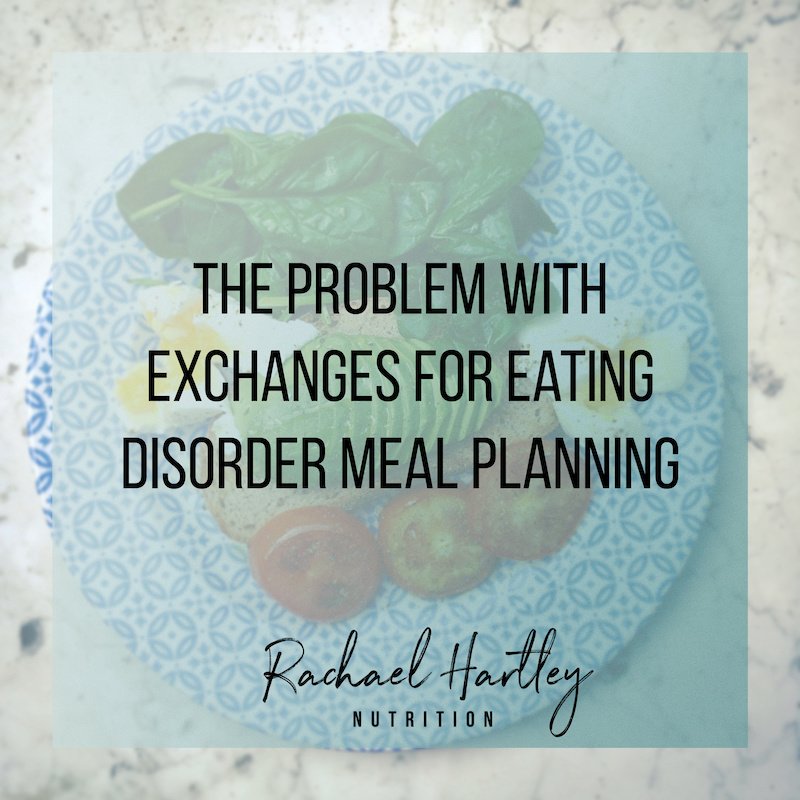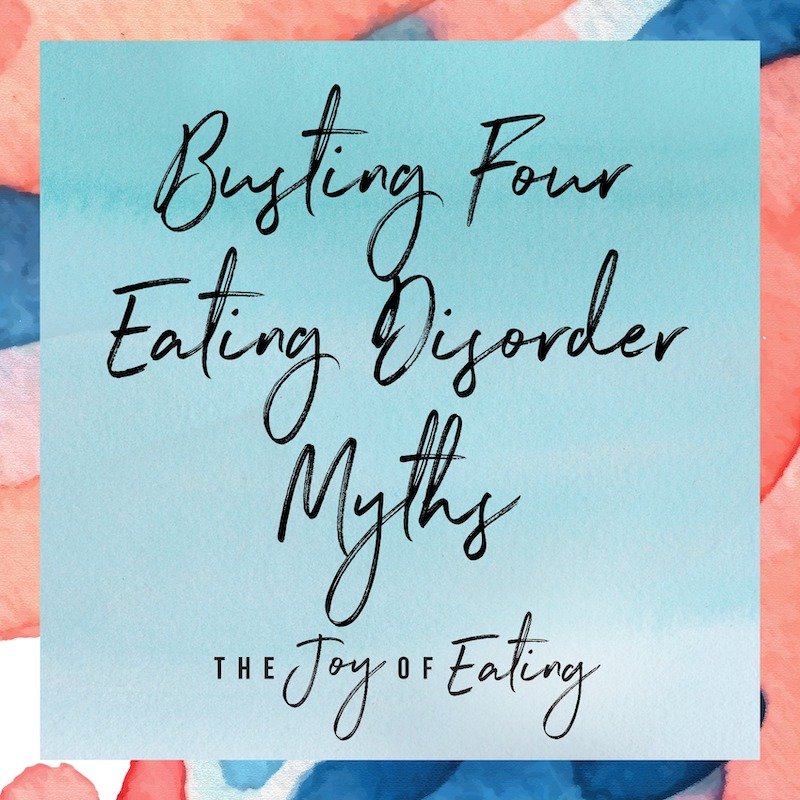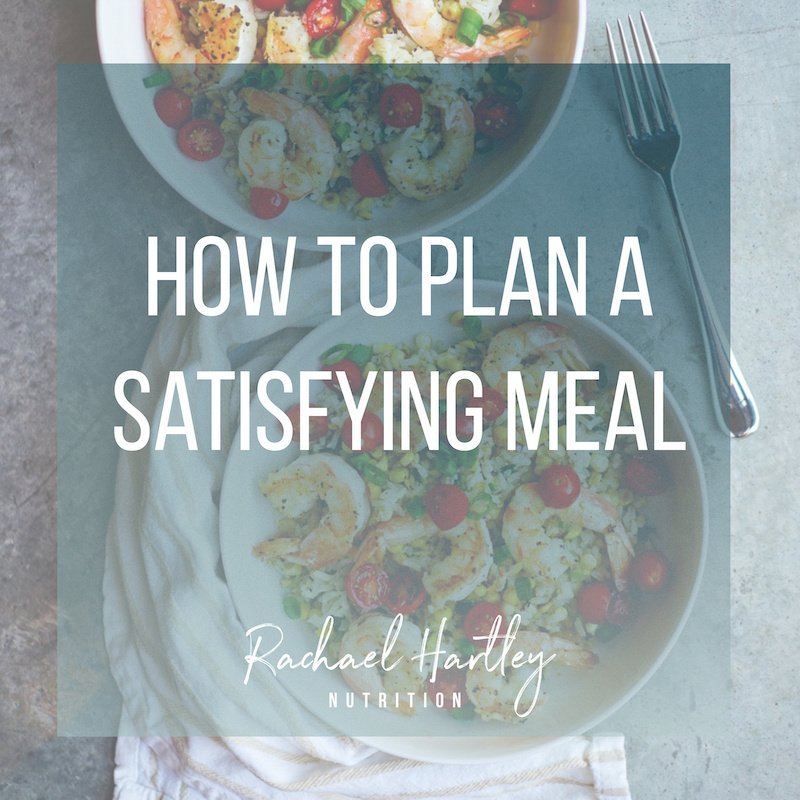Problems with Exchanges as an Eating Disorder Meal Plan
The exchange system is a common eating disorder meal plan, but it has many flaws and is often over and inappropriately used. This blog post discusses the problems with the exchange system, and shares other tools for meal planning in recovery.
If you’ve been to treatment for an eating disorder, you know what I’m talking about when I say exchanges.
If not, allow me to introduce you to the concept. Exchanges are a type of eating disorder meal plan. With exchanges, each food group is broken down into units or portion sizes that are similar in nutrition value. Exchanges were initially developed by the American Dietetic Association along with the American Diabetes Association in the 1950s as a tool for helping people with diabetes practice “portion control” and eat consistent amounts of carbohydrate from meal to meal (note: most people with diabetes do not need to use exchanges, although it can be helpful in limited circumstances). These exchanges were adapted for use in eating disorder treatment, where they are used as a tool to provide structure an adequacy to eating.
As an example, a plan might prescribe a meal that looks like this: 3 starch exchanges, 2 protein exchanges, 1 fat exchanges, 1 fruit exchange, 1 dairy exchange. While the client could choose whatever foods they like within those specific groups, they would know the serving size of foods that count as an exchange, and either measure or estimate their servings to meet their prescribed exchanges.
Now, before I dive into the problems with exchanges as an eating disorder meal plan, let me be clear that the point of this post is not to say that exchanges should never be used. If you’re on an exchange based plan and it’s helpful for you - great! While I personally rarely prescribe exchanges for a client, I work with a lot of clients who were placed on them in treatment, and it works really well for them or is helpful for the time being. While the goal is always to gradually move away from exchanges on whatever timeline is appropriate for the individual client (because no one wants to be 80 and still using exchanges), it can serve a purpose. Exchanges can be a great tool as an eating disorder meal plan, but in my opinion, it’s an over and often inappropriately used tool.
What is the Purpose of an Eating Disorder Meal Plan?
Before talking about the problems with exchanges as an eating disorder meal plan, I think it’s important to ground the conversation in the purpose of a meal plan:
Refuel the body with an appropriate amount of food, and to treat underlying malnutrition.
Help spread intake relatively evenly throughout the day.
Ensure a balance of nutrients by providing all the different macronutrients and food groups.
Ideally, an eating disorder meal plan will help a client relearn skills for creating adequate, balanced meals that they can use beyond treatment. When someone has an eating disorder, they often restrict calories, food groups, or put together odd combinations of food in an attempt to eat less. They’ve learned how to craft meals based on the eating disorders rules rather than their food preferences and body’s needs. The meal plan replaces the eating disorders rules and helps a client relearn how to feed themself.
When I work with a client in recovery, one of my goals in creating an eating disorder meal plan is to find a helpful balance of flexibility and structure. The structure is important, because we need to ensure a client has a very clear idea of how much food to eat, and prevent that sneaky ED from finding loopholes for restriction. But the flexibility is equally important, and that’s often overlooked in treatment. Rigid thinking, especially around food, is a side effect of an eating disorder. Practicing flexibility helps challenge that rigid thinking, and gives clients tools to flexibly adapt to different eating situations.
Flexible structure looks different for each client, and figuring out the most helpful balance is an individual and ongoing process.
Problems with Exchanges as an Eating Disorder Meal Plan
Here’s some of the problems I see with using exchanges for an eating disorder meal plan.
Exchanges are relatively inflexible, and replicate some of the rigidity of counting calories.
When someone is in a higher level of care, like residential or acute hospitalization, it’s often important to have a tighter control over caloric intake. The dietitian is trying to refeed their client quickly, without triggering some of the symptoms that can arise from feeding a client too much, too fast. In those cases, exchanges or even calorie counting can be a useful tool.
However, once someone is better nourished and medically stable, and especially when they are in an outpatient environment where they might be going out to eat, the rigidity of exchanges can become a bit suffocating. From a medical standpoint, while a client will still need more food and/or consistency throughout the day, there’s rarely a clinical reason for nutrition intake to be so tightly controlled. Most people don’t need to have a very specific amount of fat, protein, carbs or produce at each meal. While their body still needs all the macronutrients when they eat, it’s also OK if they have meals that are higher or lower in different macros.
I often hear from clients who have used exchanges that it felt a lot like counting calories to them. By breaking foods down into small units, it activates the same brain pathways that were used in calorie counting. It also feeds into the fear of “going over,” which brings me to my next point…
Exchanges can make it seem like there is a “right” amount of food to eat.
An eating disorder meal plan should be used to prescribe a baseline amount of food, not a limit. Exchanges can unintentionally (or unfortunately, intentionally, depending on the provider) send a message that there is a right amount of food, and going over the amount prescribed is wrong or bad. In reality, human beings are equipped to eat variable amounts from meal to meal, and benefit from that flexibility. When someone is given the message that there is a correct amount of food to eat, and that eating should be meticulously managed to prevent going over that amount, the eating disorder will flourish.
Exchanges can be difficult to adapt to real world eating situations.
Let’s use the example of exchanges I used earlier in this post. What happens if you’re going out to eat and the menu item you like doesn’t have a source of dairy included? What if you’re not sure exactly how much starch and how much protein will be on the plate? What if you’re eating at a friends house and they make a big bowl of pasta alfredo with garlic bread - plenty of carbs and fats, but no protein or produce. Or perhaps you’re attending a superbowl party that’s serving lots of appetizers and snacks, but no set meal.
For someone who doesn’t have an eating disorder, you might see these scenarios and think “so what?” But for someone with an eating disorder who is trapped in rigid thinking, these situations can create intense anxiety that makes it hard for them to feed themselves. To be fair, I think these scenarios would create anxiety for a lot of people with eating disorders, regardless of what meal plan they are on, but a more rigid exchange system plan would likely heighten it. The greater the anxiety, the more likely someone will turn to restriction as a way to cope. In creating an eating disorder meal plan, I think it’s important to ensure it allows the flexibility for going out to eat and social eating, especially since feeling less stressed in these environments is often a big part of people’s motivation for recovery.
It’s hard to remember exchanges!
I just pulled up an exchange booklet and it is a chart that is 6 pages long! Needless to say, it can be hard to keep track of the exchange portion sizes. I initially learned exchanges 17 years ago (!!!) when I was in college, and have used them to some degree or another ever since. While I’m pretty good at looking at a meal and estimating exchanges, I still often forget, especially when it comes to snack foods. When I work with clients who have been discharged on an exchange meal plan, I often keep their exchange list open in session so I can Ctrl+F when questions come up. If after 17 years, it’s still not completely intuitive to me, I can’t expect that for clients in recovery. When a client is not 100% sure if a meal fits their exchanges, they often underestimate because they are afraid of unintentionally going over.
Exchanges are designed for more Eurocentric eating patterns.
For those of you who are familiar with exchanges, I want you to consider how you might determine the exchanges in the following meals:
A meal of dim sum (a Chinese, typically Cantonese, style of meal where lots of small plates are shared) that includes shrimp dumplings, rice noodle rolls, turnip cakes, barbecue pork buns, and stuffed eggplant.
An Ethiopian meal of injera bread topped with doro wat (chicken stew), gomen (collards), and misir wat (spiced red lentils) served with sambusa (like a samosa).
A Korean meal of banchan (very small plates of side dishes, usually veggies, served first in a meal) followed by kimchi jjigae (kimchi stew).
A big bowl of posole (Mexican pork and hominy stew) served with tortillas and guacamole.
Any idea? Me neither! Exchanges are designed to fit a more Eurocentric eating pattern, where a main dish protein is typically served with a starch and vegetable or two as sides. Mixed dishes, no matter what culture they come from, are much more difficult to calculate exchanges for. This often leaves out many non-white/American people with eating disorders when they go to treatment.
Exchange-based meal plans are often come with a side of fatphobia.
Sadly, I have seen fatphobia in eating disorder treatment more times than I can count. One of the ways it’s brought into treatment is through exchanges, which are often prescribed inadequately for clients in larger bodies. My friend and fellow eating disorder provider, Shira Rosenbluth, who identifies as fat and in eating disorder recovery, has spoken extensively about how she was prescribed less food than the thin clients in treatment, even though as someone in a bigger body, and someone who extremely severe and long-lasting anorexia, her body needed more food. This can happen with any kind of meal plan, but I see this much more frequently with exchanges.
Again, I want to reiterate that none of this is to say that exchanges are bad or wrong. It’s simply to point out the limitations of an overused tool. Exchanges can be extremely helpful for some people’s recovery. If that’s you, that’s great. If you’re someone who wants to become an intuitive eater, but exchanges are providing the level of structure that you need right now, there is zero shame in that (P.S. If that’s you, I wrote a blog post on integrating intuitive eating into eating disorder recovery meal plans that might be helpful for you!)
Other Types of Eating Disorder Meal Plans
Outside of exchanges, there are other types of eating disorder meal plans that can provide a greater degree of flexibility. Here are three I use in my practice:
Rule of 3s
Developed by Marcia Herrin, the “Rule of 3s” meal plan is sort of an exchange lite. While food groups are still broken down into units similar to exchanges, it is much more streamlined. For example, the list of portion sizes I give my clients is half a page compared to the 6 pages of exchanges. The “Rule of 3” refers to three main guidelines:
Eat 3 meals daily
Eat at least every 3 hours
Include at least 3 food groups per meal
Plate-by-Plate Approach
Developed by dietitians Wendy Sterling and Casey Crosbie, the plate-by-plate approach is a visual method for plate planning. There’s no numbers, counting, or tracking involved, which is awesome! In the plate-by-plate approach, the plate is divided in to sections to be filled with various food groups. It simplifies meal planning and teaches clients how to look at a plate of food and determine whether it will be enough food, building a skill that can be used long beyond recovery. While it still is easier to use with a Eurocentric eating style, they give lots of examples and tools for adapting for mixed dishes and various cuisines.
Individualized
This isn’t exactly a formal eating disorder meal plan, but a reminder that often times what we’re doing in recovery is simply taking what someone is eating and providing individualized tools to help them round out their meals, eat more consistently, or include more balance.
At the end of the day, when it comes to finding an eating disorder meal plan that works for you, there’s no right or wrong. It’s about find the tool (or tools) that help you feed your body appropriately, supports your lifestyle, and allows for you to challenge the eating disorder’s rigidity and restrictions.
If you’re needing nutrition support in healing from an eating disorder, reach out! Depending on where you live, we can work with you virtually or out of our Columbia, SC office, or can refer you to someone in your area. Click here to learn more about our practice philosophy, and email if you’d like to see if we’re a good fit.





